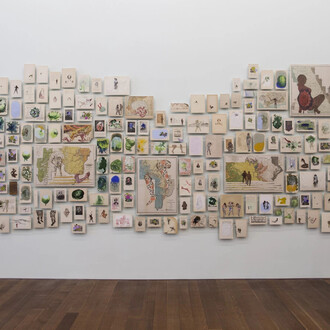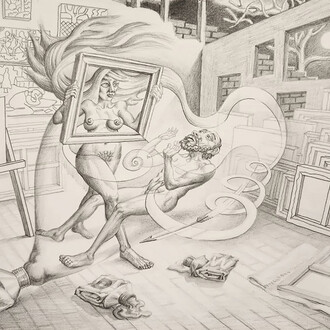McCormick Gallery is pleased to announce Rebel of the Fourth Dimension, an exhibition of paintings from the estate of Maurice Golubov (1905-1987). This is the gallery’s first showing of the artist’s work which is comprised of oil paintings and works on paper from the 1930s through the 1980s.
While Golubov enjoyed his career in New York, he was born in Tsarist Russia to a devout, Jewish family. He entered this world during a pogrom and his mother had to shelter for days with her newborn in a basement. He was groomed as a child to become a Rabbi, steeped in Hasidic Judaism, the Talmud and abstract, mystical concepts of the Kabbalah. However, young Maurice’s interests ran more toward art, although those things would inform his later life as a painter. At the outbreak of World War I, in 1915, the family became refugees and after two years of harrowing experiences they finally managed to emigrate to the United States, settling in Brooklyn, New York.
In 1918 he began attending art classes at a local settlement house where John Sloan was teaching. With Sloan’s encouragement he dropped out of school to pursue a career in art, landing a job at a commercial art firm doing advertising for mail-order firms such as Sears Roebuck and Montgomery Ward. He soon began attending classes at the National Academy of Design where he would fill the margins of his academic drawings with small, geometric abstract designs. At this time he had never visited an art museum and had no knowledge of other, abstract painter’s work, including his countrymen like Kandinsky. Yet, as a seventeen-year-old, he was making advanced, abstract works.
By the mid-1920s Golubov was exhibiting in New York with The Eight, and beginning a career that would last six decades and put him in the company of the leading artists of the day, and the revolutionary art that was produced in the 1940s, 50s and beyond. His work has been seen in over 100 solo and group exhibitions since 1926 including at the Metropolitan Museum of Art, the Whitney Museum of American Art, the Art Institute of Chicago, the Mint Museum, the Brooklyn Museum, the Pennsylvania Academy of Fine Arts, the Lowe Art Museum and the Jewish Museum. He showed in commercial galleries in New York including The Artist’s Gallery (1941-53), AAA (1944 and annually), Mortimer Brandt (1945), Betty Parsons (1946), Zabriskie (1956), Mayer Gallery (1959), and Tibor de Nagy Gallery (1976-89).
Early in his career Golubov began formulating an abstract pictorial construct, a concept found in his Fourth Dimensional paintings — a reality outside our immediate vision. He saw this as: “an illogical world that would be logical only as a picture, a world where endless moments are arrested into one whole instant moment.” This journey was colored and informed by his early exposure to Hebrew mysticism as a boy in Russia. These radical, rebelliously beautiful works of art will be on view in the gallery this summer through August 4.














